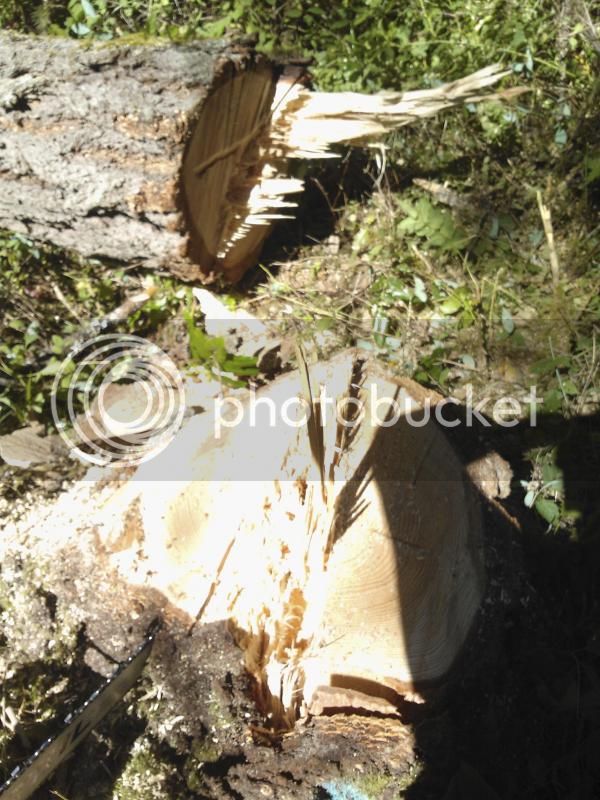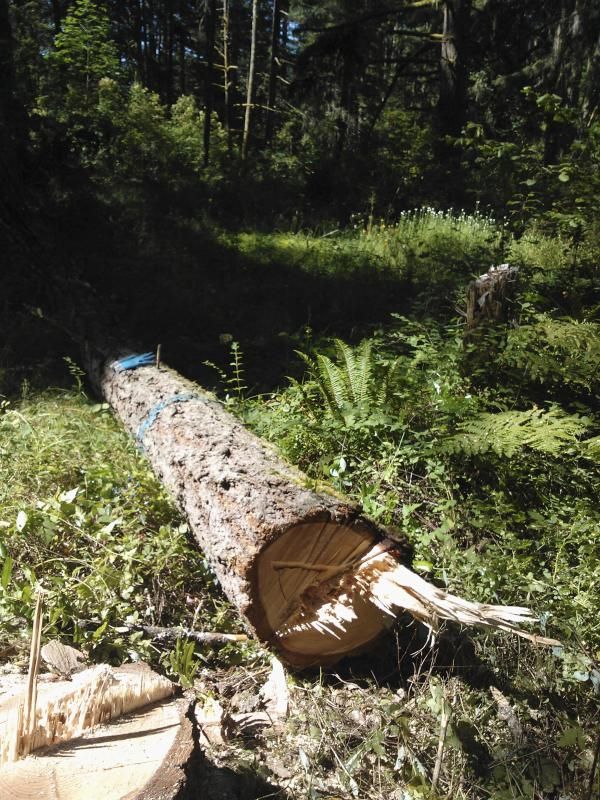You are using an out of date browser. It may not display this or other websites correctly.
You should upgrade or use an alternative browser.
You should upgrade or use an alternative browser.
Falling pics 11/25/09
- Thread starter Burvol
- Start date

Help Support Arborist Forum:
This site may earn a commission from merchant affiliate
links, including eBay, Amazon, and others.
What lengths are normal for the pnw? Are they bucked shorter at the mill or processes as delivered?
The trim allowances for softwoods are well-covered up there. I have here the card for one of our local hardwood mills. Here are the lengths used hereabouts for alder and maple.
min top dia 6" alder, 7" maple
max butt dia 30"
chip 'n' saw 5" min (absolute
pulp 3" min, must be suitable for conveyor travel
Log -- Trim -- Preference
16' -- 16'8" -- acceptable
18' -- 18'8" -- preferred
20' -- 20'8" -- preferred
22' -- n/a -- no 22' allowed
24' -- 25'0" -- least preferred
26' -- 27'0" -- acceptable
28' -- 29'0" -- preferred
30' -- 31'0" -- preferred
32' -- 33'4" -- least preferred
34' -- 35'4" -- acceptable
36' -- 37'4" -- acceptable
38' -- 39'4" -- preferred
40' -- 41'4" -- preferred
Metals406
Granfodder Runningsaw
Some of the mills are geared up for the 9' stud market. The mill I currently sale to has a three inch trim per 9'. And 27'9" is their favorite length. They will take tops down to 6" and have taken down to 5.25" w/o deductions. The best saw logs go to a small Mom n Pop band mill(they pay real gooooooooda!)and the rest go to a privately owned local mill in ColumbiaFalls, Mt..
PM me the mom and pop info if they pay good, unless it's super secret? I can pass it on the Ron so he could maybe sell to them as well?
I assume the other mill you're talking about it Stoltze or RBM?
1270d
ArboristSite Guru
Are there published specs for allowable sweep in a log? Is it based on the sections the longer lengths will eventually be bucked into or on the whole log?
For example our veneer logs can have maybe a half inch of sweep, while saw bolts can be up to eight inches since they are bucked in half at the mill
For example our veneer logs can have maybe a half inch of sweep, while saw bolts can be up to eight inches since they are bucked in half at the mill
Are there published specs for allowable sweep in a log? Is it based on the sections the longer lengths will eventually be bucked into or on the whole log?
You sort of just answered your own question. Logs are always scaled from the small end; you can make better utilization of a defective log by bucking it into shorter lengths. Longer pieces are worth more. The guy bucking makes some of these decisions, the scaler some, and the guy running the headrig makes the final call.
paccity
Addicted to ArboristSite
starts at the faller, if it's not layed out as gently as poss everything else is out the window. :msp_wink:
Bandit Man
ArboristSite Operative
Another steamy day in the holler, but wouldn't trade this life for anything.
Well..... Maybe to be the sailboat Captain for Hugh Heffner
View attachment 305668
Oh, I took this pic for my daughter, and tossed the Stihl Forestry hat so she could see me.
Well..... Maybe to be the sailboat Captain for Hugh Heffner
View attachment 305668
Oh, I took this pic for my daughter, and tossed the Stihl Forestry hat so she could see me.
there really is an art to bucking for grade, you east coast guy have it down to a mad science what with all the peeler logs and what not, plus hard wood generally doesn't grow real straight.
Here its watch for cat butt, big knots and too much taper, any obvious defect, other then that they all pretty much turn into grade lumber or TP...
Here its watch for cat butt, big knots and too much taper, any obvious defect, other then that they all pretty much turn into grade lumber or TP...
J
jrcat
Guest
For the markets I deal with on veneer we are allowed no percentage of sweep. On saw logs .....as long as they can get it on the carriage without much hassle it will go for what ever it grades out as ex: grade 1, 2 or 3 .... Most logs with a sweep will bring at least a 2. I have sold some that went for 1's ... Depends on the scale man too.
Bandit Man
ArboristSite Operative
Really enjoying falling the tall reds, but can't wait to take vacation.
View attachment 305836
View attachment 305836
It was too close to tell, so I opted for more work and a safer outcome. The little alder was getting too big.
This was what I did not want to break.
View attachment 306017
So I topped it first using my "bargain" wiggly wobbledy muscle powered pole saw. I'll finish it on a day when I feel like wearing long pants. The bottom is in a blackberry vine patch. Windows are in one piece. Objective met.
View attachment 306018
I used a slopping back cut.
This was what I did not want to break.
View attachment 306017
So I topped it first using my "bargain" wiggly wobbledy muscle powered pole saw. I'll finish it on a day when I feel like wearing long pants. The bottom is in a blackberry vine patch. Windows are in one piece. Objective met.
View attachment 306018
I used a slopping back cut.
Last edited:
Get a power pole saw. I have murdered everything around my house...and wherever else I want to prune. I can get up 16' off the ground.
No thanks. I've cut with both. The muscle powered is lighter and low maintenance.
Finally had cause to try Cody's alternate siswheel method (the one where you slide the cut off the face rather than pulling out a wedge behind it) and found it to be easier and more effective. Turns out the question isn't so much how far can you pull it but rather how far do you need to pull it.

As you can see, I overshot by just enough to inconvenience myself.


As you can see, I overshot by just enough to inconvenience myself.

treeslayer2003
Addicted to ArboristSite
I like to see more on this, pics. hard to see jus what ya did.
I like to see more on this, pics. hard to see jus what ya did.
There's plenty of pics in this thread, if you want to dig around some. I'm mostly going by memory from watching him do it at the Montana GTG last year.
HuskStihl
Chairin'em for the sound
It was too close to tell, so I opted for more work and a safer outcome. The little alder was getting too big.
This was what I did not want to break.
View attachment 306017
So I topped it first using my "bargain" wiggly wobbledy muscle powered pole saw. I'll finish it on a day when I feel like wearing long pants. The bottom is in a blackberry vine patch. Windows are in one piece. Objective met.
View attachment 306018
I used a slopping back cut.
Strong work! I've never seen a "T" type coos bay executed with a muscle powered pole saw before:biggrin:
Rounder
Addicted to ArboristSite
Pretty nice Friday strip, 3-4+ long log timber.
Hope you all had a good, safe week - Sam
View attachment 306085
View attachment 306086
View attachment 306087
View attachment 306088
View attachment 306089
Hope you all had a good, safe week - Sam
View attachment 306085
View attachment 306086
View attachment 306087
View attachment 306088
View attachment 306089
Similar threads
- Replies
- 1
- Views
- 662
- Replies
- 37
- Views
- 3K
- Replies
- 55
- Views
- 9K



